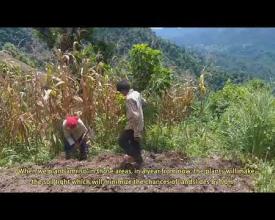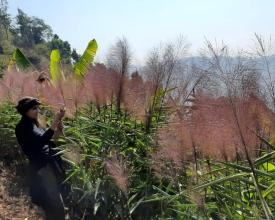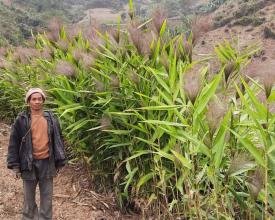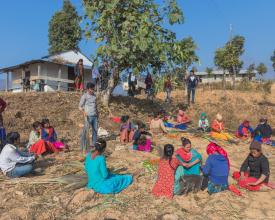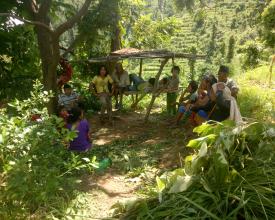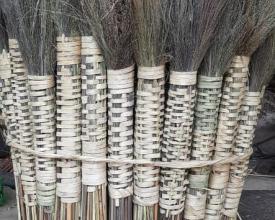
Creating a Bio-engineering social enterprise
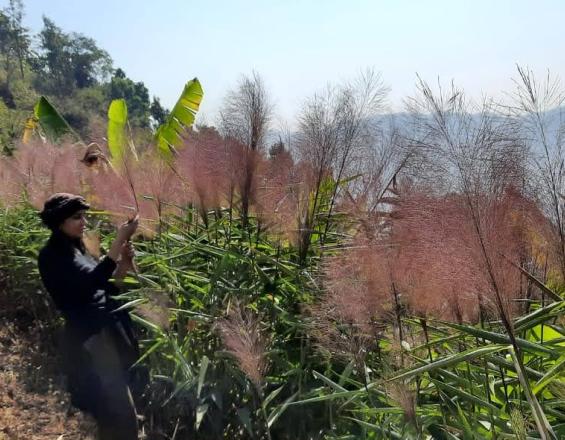
The lowland hilly ranges in Nepal are geologically young and tectonically active, posing a huge issues of geo-disasters such as landslides, soil erosion and environmental degradation. The area is also home to tribal communities who along with living at risk of environmental hazards experience a range of livelihood challenges shaped by historic socio-economical marginalization.
In order to mitigate natural disasters such as floods and landslides which are frequent in the hilly terrains, this nature-based solution aims to plant Broom Grass and Bamboo on degraded lands and landslide prone areas, to save the households at risk communities while also addressing their economic issue by training them on social enterprise and finding the market for the produced goods from, those planted cash crop.
Broom grass and bamboo are able to mitigate landslide and pose a huge financial potential as their byproducts such as brooms, bio fuel, papers and handicraft are in huge demand in global market.
Context
Challenges addressed
The main challenges that we faced were
Environmental: The plantation areas had to be done on terrains where landslides were frequent and soil was loose, posing the danger of work accidents. Therefor the plantation had to be done very cautiously.
Social: Because the solution required the beneficiaries to spend couple of months during plantation and some weeks in capacity building workshops, it deprived them of the earnings they could have made doing manual labor works during that time.
Economic: Since this is a multi-year project, done by the newly created organization/group, raising funds was challenging.
Location
Process
Summary of the process
The organization facilitating this solution plays a vital part in linking these bulding blocks and making them co-dependable.
During the pilot phase of the project, Community Sensitization was done on large scale to interact and enroll the beneficiaries in the project and creating alliances. The beneficiaries and the implementing organization worked directly with these alliances on various levels to ensure their direct involvement in the success of this solution. The co-operative committee that was formed before the implementation phase for planning, management, implementation and marketing of the products conists of the beneficiary community as well as the alliances.
Building Blocks
Community participation
The communities living in thes project landscapes are directly involved in all phases of this project: household selection, area(s) selection, plantation and supervision of all activities. The project promotes active participation and involvement in decision-making processes.
Enabling factors
- Community sensitization, to make them aware of the problem
- Reliability on indigenous knowledge about nature based solutions
- Understanding that the project is in the interest of national and global donors, but should ultimately be in-line with the local, regional and national priorities
- Trust between the community and the organization had to be developed
Lesson learned
During the inception of this project we relied heavily and in some cases solely on the local's knowlede and age old indegenious craft. But during the process we came to know that some of the componenets were irelevant and had to be balanced with some modern techniques and technologies too.
We also learned that, the interest of the community and the local political will doesnt always match.
Alliances
Various alliances had to be build to ensure the success of the programme. Collaboration was necessarry between the following stakeholders:
- Local and provincial government and administrative authorities
- Social groups like youth clubs, women groups, agriculture committees
- Forest and land protection committes
- Local, regional and national private sector businesses
- Various experts, researchers and scholars in this sector
Enabling factors
Since this solution involves multi-level activities from planning, implementation, conservation, monitoring, marketing and promoting, it becomes essential to bring all the stakeholders together and interlink them through common goals and their ascribed responsibilities by the state and the society.
Lesson learned
- Stakeholders don't always have the same interests and goals
- Conflict between the stakeholders in the alliances are common because of their interests
- The thoroughness of legal aspects while dealing with the local bureaucracy is needed
- The awareness of greater good has to be evoked to all the stake holders, time and again
Co-operative farming for sustainable livelihood
An institutional support is required for the beneficiaries to promote the products they make through this solution, in local, regional and national markets. Since a single farmer cannot meet the quantity demand of the market and the distributors look for bulk quantity, a functioning co-operative has to be formed at the local level. This cooperation serves the purpose of collecting the products, negotiating the price with the distributor, supervising the manufacturing and distributing the profits.
Enabling factors
There is a high demand for brooms and associated products in the local, national and international market and distributors always buy in bulk. By applying cooperative farming methods, it will be easier for a single farmer to supply their product and get a reasonable rate for it. Instead of approaching single farmers, distributers negotiate prices with the cooperative committee, which also guarantees more stable and profitable prices for their members.
Lesson learned
- The leadership of the cooperative committee should be entrusted to persons in the community who are knowledgeable about the market.
- The co-operative should be made bipartisan and fair to everyone.
Impacts
Impacts created through the implementation of this solution in the pilot phase are:
- Mitigation of geo-disaster such as landslides, flash floods, soil erosion and overall environmental degradation
- Improvement of livelihoods of tribal and marginalized communities living in the proximity of the area through the sale of products from the cash crops
- Promotion of the tribal and indigenous knowledge
Beneficiaries
The tribal communities living in those areas who have been historically marginalized both politically and economically. Most of the beneficiaries live under the poverty line. While conducting the project female-led households were given priority.
Sustainable Development Goals
Story

The gentelman in the photo inherited some land after the demise of his parents. Since he was young at the time of the allottment, he was given the degraded part by his elder brothers who took away the arable land. Because of the loose soil his land had frequent landslides and was not suitable to plant anything. He enrolled in this project and learned about broom grass plantation through the workshop given by this organization and started planting broom grass on his land to combat degradation. There have not been a single instance of landslide since and he was able to produce and sell brooms in the market earning an income. Through his plantation the soil became less loose and its properties improved.
